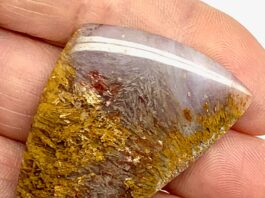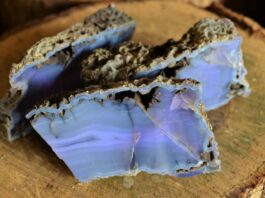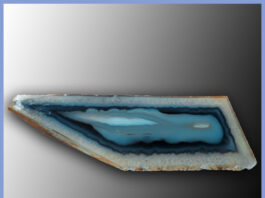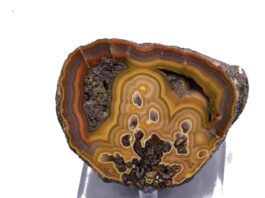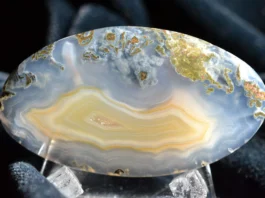Andara Glass refers to a type of glass found primarily in certain regions of the United States, particularly in northern California and the Sierra Nevada mountains. It is characterized by its vibrant colors, which range from translucent to opaque and come in various hues such as green, blue, purple, and pink. Andara Glass is often polished and shaped into various forms such as spheres, points, or jewelry pieces.

Origin: The origin of Andara Glass is somewhat shrouded in mystery and speculation. Some proponents believe that Andara Glass is not merely a product of geological processes but is instead formed from ancient extraterrestrial materials or remnants of a lost civilization. However, scientifically, Andara Glass is considered to be a type of obsidian, a naturally occurring volcanic glass formed when molten lava cools rapidly.
Historical Background: The modern interest in Andara Glass can be traced back to the early 2000s when metaphysical practitioners and spiritual healers began to claim that the glass possessed powerful energy properties. Some individuals assert that Andara Glass contains high vibrational frequencies that resonate with the human energy field, facilitating healing, meditation, and spiritual growth.
While the historical background of Andara Glass as a mystical tool is relatively recent, the concept of using stones and crystals for healing and spiritual purposes has ancient roots. Throughout history, various cultures have utilized gemstones and minerals for their purported healing properties and spiritual significance.
In summary, Andara Glass is a type of glass found in certain regions of the United States, known for its vibrant colors and believed by some to possess mystical and metaphysical properties. While its origin is rooted in geological processes, its modern significance lies in its purported ability to aid in spiritual healing and personal transformation.
Contents
Geographical locations where Andara Glass is found

Andara Glass is primarily found in specific regions of the United States, particularly in northern California and the Sierra Nevada mountains. These areas are known for their volcanic activity, which plays a crucial role in the formation of Andara Glass. Some specific locations where Andara Glass has been reported or collected include:
- Mount Shasta, California: Mount Shasta and its surrounding areas in northern California are renowned for their spiritual significance and geological diversity. Andara Glass specimens have been reportedly found in this region, attracting metaphysical practitioners and spiritual seekers.
- Eastern Sierra Nevada Mountains, California: The Eastern Sierra Nevada mountain range, which includes areas like Mono Lake and the Mammoth Lakes region, is another known location for Andara Glass. This area has a history of volcanic activity, contributing to the formation of obsidian-based materials such as Andara Glass.
- Northern California Coast: Some reports suggest that Andara Glass may also be found along the northern California coast, particularly in areas where volcanic activity has occurred historically.
While these regions are known for their association with Andara Glass, it’s essential to note that the exact locations where Andara Glass is found may vary, and the collection of Andara Glass specimens is often subject to local regulations and restrictions. Additionally, due to the speculative and metaphysical nature of Andara Glass, claims regarding its specific geographical origins should be approached with critical scrutiny.
Physical Characteristics of Andara Glass

Andara Glass exhibits several distinct physical characteristics that contribute to its unique appearance and allure. These characteristics include:
- Vibrant Colors: One of the most striking features of Andara Glass is its vibrant and often translucent colors. These colors can range from deep blues, greens, and purples to softer pinks, oranges, and yellows. Some specimens even exhibit a multi-hued or iridescent appearance, adding to their visual appeal.
- Translucency and Opacity: Andara Glass can vary in translucency, with some specimens being nearly transparent, allowing light to pass through, while others are more opaque. The degree of translucency can affect the way light interacts with the glass, giving it a luminous quality.
- Smooth Texture: Andara Glass typically has a smooth texture, resulting from the polishing process used to shape and refine the raw material into various forms such as spheres, points, or jewelry pieces. This smoothness enhances the glass’s aesthetic appeal and tactile experience.
- Glassy Luster: As a type of glass, Andara Glass exhibits a glassy luster when polished, giving it a reflective and glossy surface. This luster contributes to its visual appeal and can enhance the perception of its colors and translucency.
- Unique Patterns and Inclusions: Some Andara Glass specimens may contain unique patterns, swirls, or inclusions formed during the glass’s crystallization process. These patterns add to the individuality of each piece and can contribute to the overall aesthetic appeal.
- Brittle Nature: Like other types of glass, Andara Glass is relatively brittle and can chip or break if not handled carefully. This fragility necessitates gentle handling and proper care to maintain the integrity of the specimens.
Composition and formation process

The composition and formation process of Andara Glass are tied to its geological origins and the conditions under which it is formed. While there is ongoing debate and speculation about the precise nature of Andara Glass, particularly within metaphysical and spiritual communities, from a scientific perspective, it is considered a type of obsidian, a naturally occurring volcanic glass. Here’s an overview of its composition and formation process:
Composition: Andara Glass shares its basic composition with other types of obsidian, primarily consisting of silicon dioxide (SiO2), the same chemical compound found in quartz. However, unlike quartz, which forms crystals, obsidian lacks an ordered internal structure due to its rapid cooling from molten lava, resulting in an amorphous or non-crystalline structure.
In addition to silicon dioxide, Andara Glass may contain various trace elements and impurities, which contribute to its distinctive colors and properties. These elements can include iron, magnesium, potassium, and others, depending on the specific geological conditions where the glass is formed.
Formation Process: Andara Glass is formed through volcanic activity, specifically during the rapid cooling of molten lava. When magma from deep within the Earth’s mantle rises to the surface during volcanic eruptions, it undergoes a rapid decrease in pressure, causing it to cool quickly and solidify into glassy material.
The formation of Andara Glass is thought to occur under specific conditions that promote the incorporation of trace elements and impurities into the glass matrix, leading to its characteristic colors. The exact mechanisms responsible for the vibrant hues of Andara Glass are not fully understood and remain the subject of scientific inquiry and speculation.
While the geological processes responsible for the formation of Andara Glass are well-established, its association with metaphysical properties and mystical origins is a matter of belief rather than scientific evidence. Proponents of Andara Glass often attribute its unique properties to energetic influences or extraterrestrial origins, although such claims lack empirical support within mainstream scientific discourse.
In summary, Andara Glass is primarily composed of silicon dioxide and forms through the rapid cooling of volcanic lava. Its distinctive colors and properties arise from the incorporation of trace elements and impurities during the formation process. While its geological origins are well-understood, its purported metaphysical properties remain a matter of personal belief and interpretation.
Uses

The uses of Andara Glass vary depending on the perspective of the individual or group engaging with it. While some view Andara Glass primarily through a spiritual or metaphysical lens, others may appreciate it for its aesthetic qualities or potential healing properties. Here are several common uses of Andara Glass:
- Spiritual and Energetic Work: Many individuals and practitioners believe that Andara Glass possesses unique energetic properties that can aid in spiritual growth, meditation, and healing. It is often used in energy work, chakra balancing, and other spiritual practices to facilitate alignment, clarity, and connection with higher consciousness.
- Meditation and Mindfulness: Some people incorporate Andara Glass into their meditation practices to deepen their focus, enhance visualization, and access altered states of consciousness. The vibrant colors and unique energy of Andara Glass are thought to support relaxation, concentration, and inner exploration.
- Healing and Well-being: Advocates of Andara Glass claim that it has healing properties that can support physical, emotional, and mental well-being. It may be used in alternative healing modalities such as crystal therapy, Reiki, and holistic medicine to address various ailments, promote vitality, and restore balance to the body’s energy systems.
- Personal Growth and Transformation: For many individuals, Andara Glass symbolizes transformation, renewal, and personal evolution. It may serve as a catalyst for self-discovery, inner healing, and spiritual awakening, helping individuals navigate life transitions, release limiting beliefs, and align with their higher purpose.
- Decorative and Ornamental: Beyond its spiritual and metaphysical associations, Andara Glass is valued for its aesthetic appeal and beauty. It is often displayed as decorative objects in homes, offices, and sacred spaces, adding a touch of color, elegance, and positive energy to the environment.
- Jewelry and Wearable Art: Andara Glass is frequently crafted into jewelry pieces such as pendants, earrings, and bracelets, allowing individuals to carry its energy with them throughout the day. These wearable art pieces not only serve as adornments but also as talismans or amulets imbued with personal significance and intention.
- Collecting and Specimen Appreciation: Some collectors and enthusiasts are drawn to Andara Glass for its rarity, uniqueness, and potential investment value. They may acquire specimens of Andara Glass for their personal collections, appreciating the diversity of colors, patterns, and energetic qualities present in each piece.
Overall, the uses of Andara Glass are diverse and multifaceted, reflecting its significance across spiritual, aesthetic, and holistic dimensions. Whether utilized for spiritual exploration, healing practices, or simply admired for its beauty, Andara Glass continues to captivate and inspire individuals seeking connection, transformation, and personal empowerment.
Types and Colors of Andara Glass

Types of Andara Glass:
- Translucent Andara Glass: This type of Andara Glass allows light to pass through, giving it a semi-transparent appearance. It often appears smooth and glossy, with colors ranging from subtle pastels to vibrant hues.
- Opaque Andara Glass: Opaque Andara Glass does not transmit light, resulting in a solid appearance. It can have a matte or glossy finish, and its colors may be more intense and saturated compared to translucent varieties.
- Iridescent Andara Glass: Some Andara Glass specimens exhibit iridescence, displaying a play of colors that shift and change depending on the angle of light. This effect is caused by the interaction of light with microscopic surface features or inclusions within the glass.
Colors of Andara Glass:
- Blue Andara Glass: Shades of blue Andara Glass range from pale sky blue to deep indigo. Blue Andara Glass may evoke feelings of calmness, serenity, and expansiveness.
- Green Andara Glass: Green Andara Glass can vary from light mint green to rich emerald green. It may symbolize growth, renewal, and vitality, reminiscent of lush forests and meadows.
- Purple Andara Glass: Purple Andara Glass comes in hues ranging from soft lavender to royal purple. It may evoke qualities of intuition, spirituality, and inner wisdom.
- Pink Andara Glass: Pink Andara Glass exhibits shades of soft rose pink to vibrant magenta. It may convey feelings of love, compassion, and emotional healing.
- Yellow Andara Glass: Yellow Andara Glass ranges from pale lemon yellow to golden amber. It may symbolize sunshine, positivity, and optimism.
- Orange Andara Glass: Shades of orange Andara Glass can vary from peachy coral to fiery orange-red. Orange Andara Glass may evoke feelings of creativity, enthusiasm, and passion.
- Clear Andara Glass: Clear Andara Glass is transparent, allowing for unobstructed viewing of its internal structure. It may symbolize clarity, purity, and spiritual insight.
These are some of the observable types and colors of Andara Glass, appreciated for their visual appeal and aesthetic qualities.


